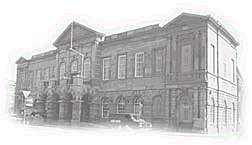| Longton - one of the Six Towns of Stoke-on-Trent |
|
Tunstall
|
| Longton - one of the Six Towns of Stoke-on-Trent |
|
Tunstall
|
"Bennett referred to Longton as Longshaw in his Five Town Novels. It is the least mentioned of the Pottery towns in his Five Town novels . Bennett compared the conurbation as being akin to Hell. Pictures of the area during its industrial growth defy belief with smoke pouring from a multitude of chimneys in amongst bottle ovens of various shapes and sizes. The great concentration of these ovens and the situation of Longton being in a slight hollow, made it the most polluted of all the pottery towns." Arnold Bennett | Arnold Bennett's Longton |

Anchor Works, Longton - corner of Sutherland
Road and Anchor Road
the body of the bottle kilns is in the
range buildings with just the chimney showing
Longton
is the newest of the six towns and was originally laid out as an
agricultural village in the thirteenth century.
Lord of the Manor - The Duke of Sutherland and John E Heathcote, Esq, own a great part of the land in both liberties, and the latter is lord of the manor, and owner of Longton Hall "LANE END, a populous and thriving
market-town, and with LONGTON, forms an extensive township, situated
five miles south-east of Newcastle,, at the southern extremity of the
Potteries, and has risen in a few years by the almost magical influence
of a prosperous manufacture to a respectable degree of opulence. "As early as 1756, a manufactory
of English porcelain was established here, and ware of great lightness
and beauty was produced, fully equaling that for which Chelsea was
famous. It will thus be seen that Longton deserves to rank with Burslem
as one of the historic towns of the Potteries. Longton, which is
situated in the extreme south of the district, is connected by the Stoke
and Derby branch of the North Staffordshire Railway with the great trunk
lines of England, and so enjoys excellent facilities for transport
purposes." Dates in the history of Longton 1789 - Longton's Times Square laid out. 1811 - Population - Longton: 4930 1844 - Longton's first Town Hall built, soon replaced in 1863. 1865 - Longton created a borough. 1863 - Longton Town Hall replaced, by the present building in Times Square. 1911 - Population - Longton: 37,479
|
 Longton Town Hall Longton has had two Town Halls
|